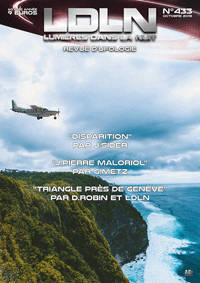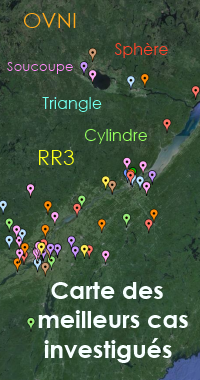Yann Vadnais' conference (Canada) at the international conference CAIPAN 2, organized by CNES/GEIPAN
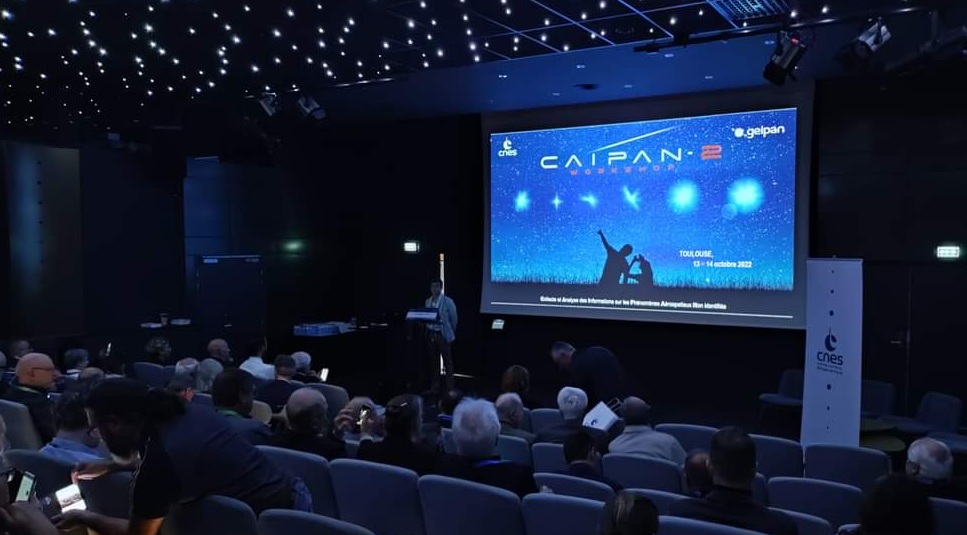
The 13-14 last October took place in Toulouse (France) one of the most prestigious international symposiums touching on the controversial field of ovniology, i.e. phenomena associated with sightings of UFOs and UAPs (“unidentified aerospace/aerial phenomena”). The’Workshop « CAIPAN 2 » was organized by the GEIPAN and the National Study Centerspatiales (CNES). The first edition of the event dated from 2014 (Click here pour access to the CAIPAN conferences of 2014).
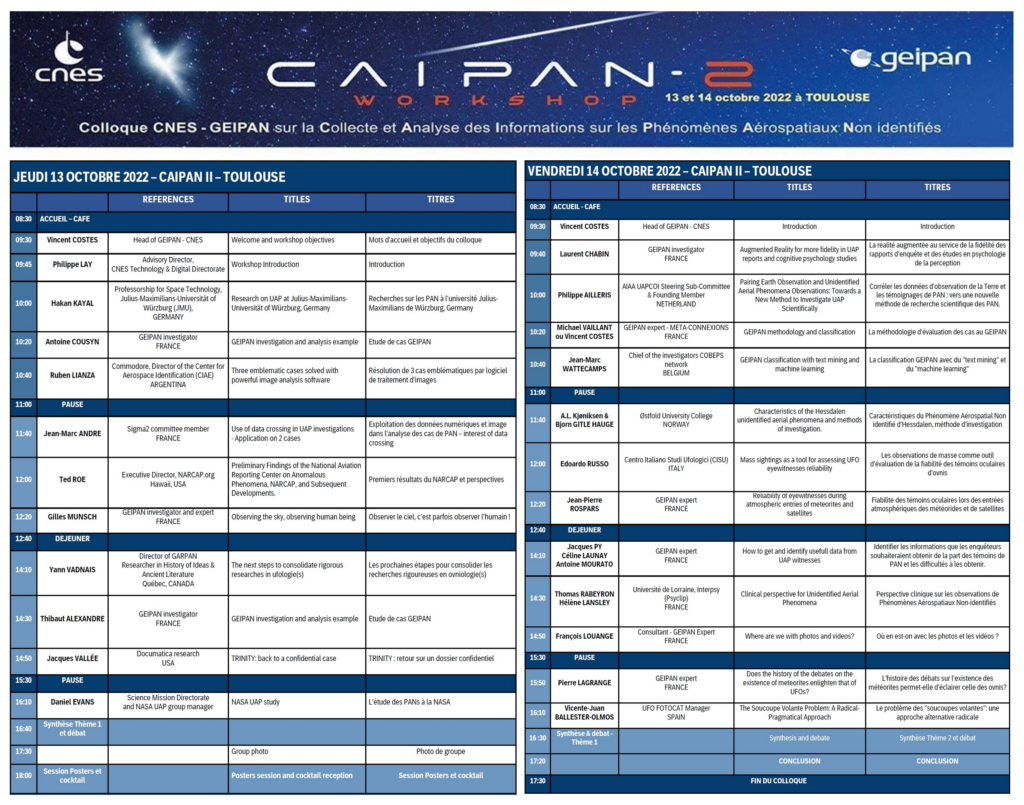
Acronym CAIPAN means “Collection and analysis of information on UAPs”, and precisely the symposium was oriented on the reception and treatment of evidence and corollary information relating to thephysical environment, of witness and sound psychosocial environment ; you will have recognized the four observable data of the methodological approach of the GEIPAN :
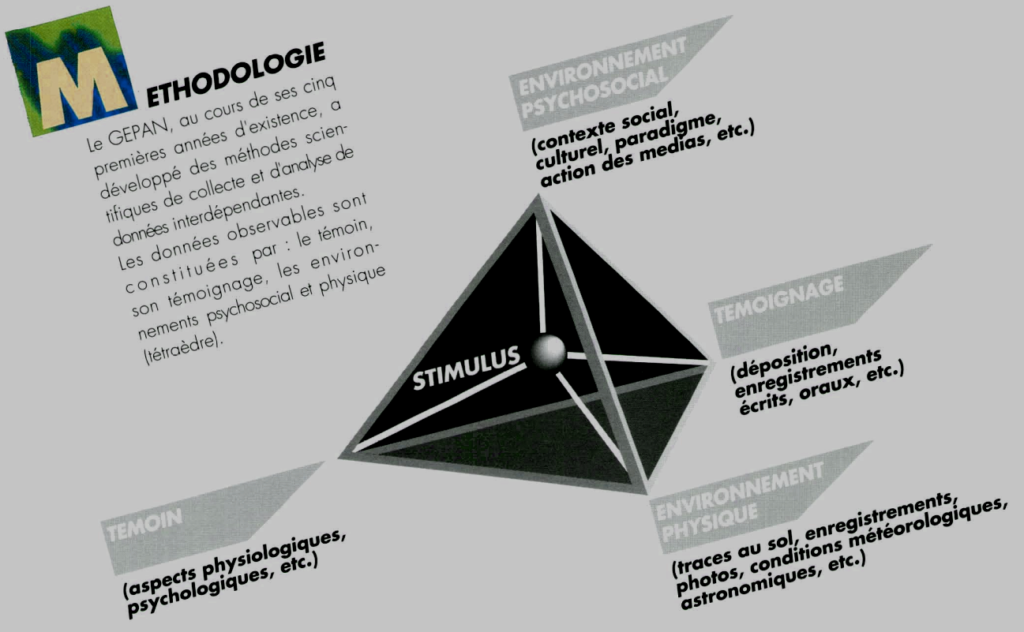
Of the hundred guests who had the privilege of attending this event, twenty two (22) were speakers, while about twenty others had a science posters in the showroom. Most of the speakers were Europeans (France, Belgium, Italy, Sweden, Norway, Hollande, Germany) and three were from North America:
- Ted ROE, the director of NARCAP (National Reporting Center on Anomalous Phenomena), the United States ;
- Jacques VALLEY, the most famous personality in the modern history of ufology, the United States ;
- What about me, Yann VADNAIS, president of the learned society SieTThe and director of GARPAN (from 2012), from Canada.
The first reason for which I was invited — following the formal acceptance of my proposition de communication that is here -:

… is that the subject proposed was in accordance with the heuristic aspirations of the colloquium and with one of the two themes announced : tasks conducive to the development of “studies on UAPs”. The second theme concerned "technical methodologies, scientific approaches and expertise for studies on UAPs ».
The second reason for which I was invited is that the Scientific Steering Committee symposium (composed of eighteen members) :

… wanted the presence of a representative of the new learned society that we founded in March 2022: the International society for transdisciplinary studies in ovniology (SIÉTO), of which I was elected president for the year 2022-2023.
It must therefore be understood that I went to this conference – bringing together many of the most serious and honorable researchers in ovniology – with a sense of responsibilityand college duty :
1. First I had to properly represent the venerable tradition of ovniology in Canada, who is two-headed — both French-speaking (in Quebec and the Maritime provinces) and English speaking (in the rest of the country) :
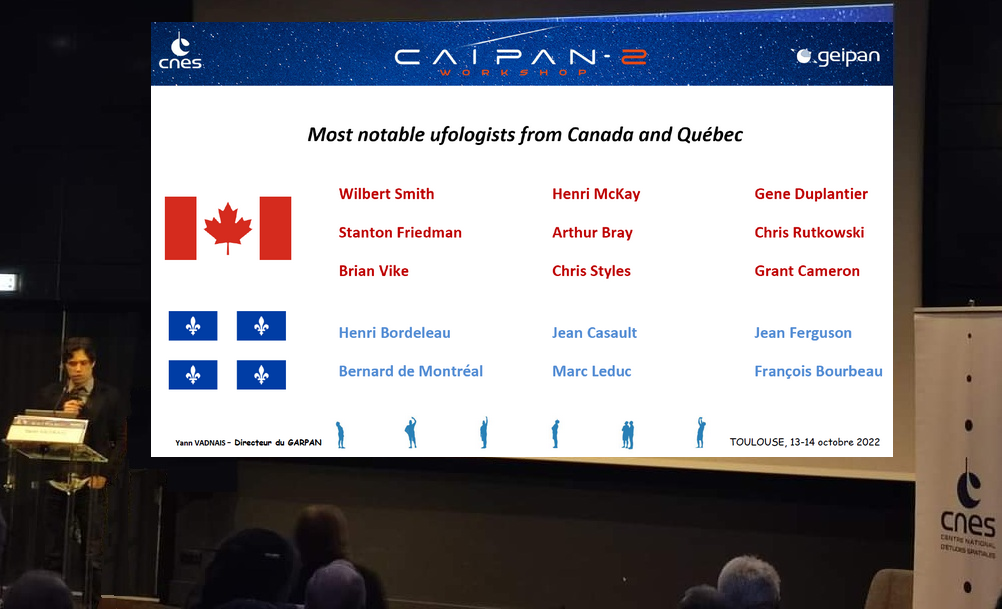
2. I then had to represent the Internati Companyshethe transdisciplinary studies in ovniology (SIÉTO) which includes twenty-five (25) members from five countries :
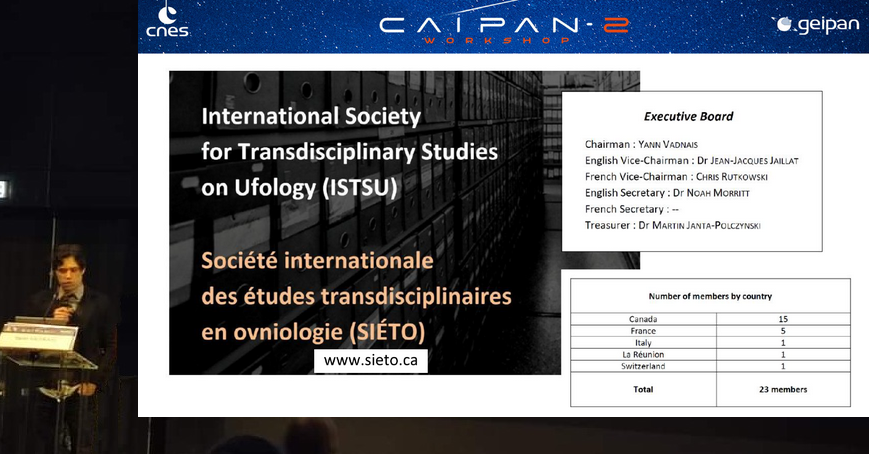
This learned society has set itself three goals that have been hoped for for decades in the heterodox field of research associated with UFOs. The objective of’allocate a scholarship (of 1000 $ CA) to students doing a master's or a doctorate whose subject is related to ovniology has already been accomplished and was officially announced during my performance (see penultimate photo below) :
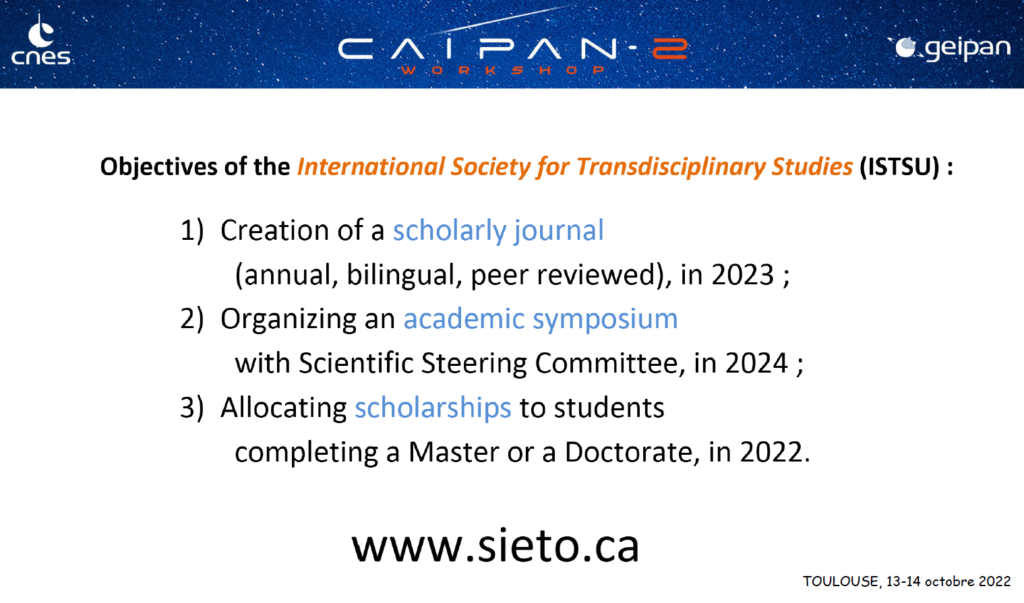
The fact that a scholarship is now offered to master's or doctoral students does it not deserve to be underlined? ? Isn't this an accomplishment that lends credibility to the discipline of UFO studies? ?
The objectives of my presentation were therefore above all to achieve a decisive contribution to development, to the constitution and development of the specialized research discipline in ovniology. My communication was therefore entitled : “The next steps to consolidate rigorous research in ovniology(s) » :
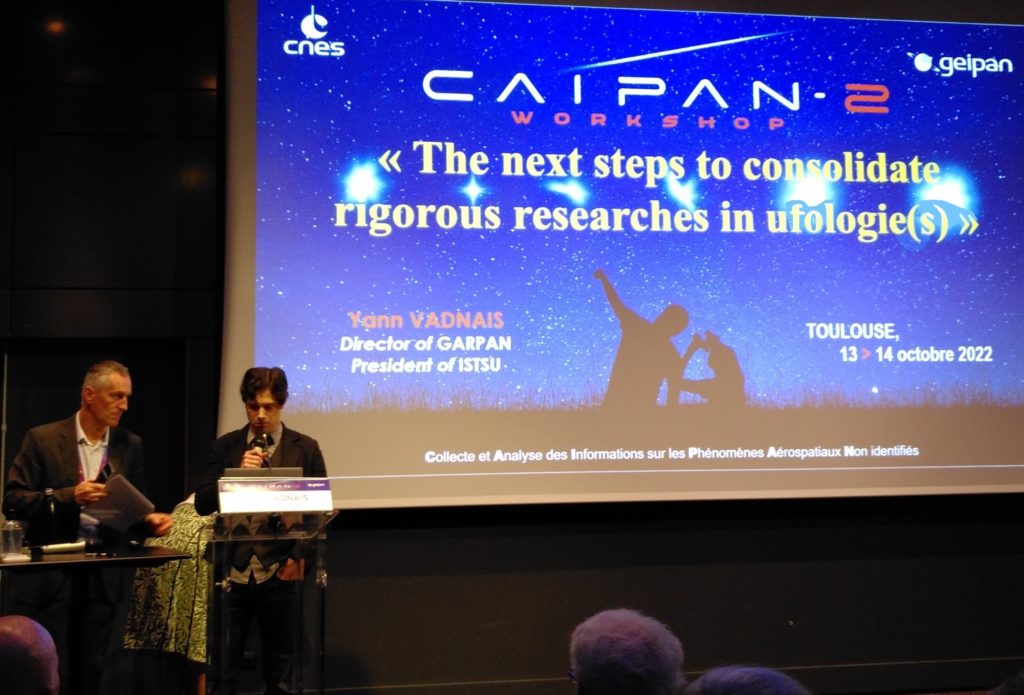
(Photo by Bruno Mancusi)
Echoes in the media
Up & rsquo; for now, the only media that relayed the news of this notable event is the popular online magazine The Debrief with an article by Baptiste FRISCOURT: « The French Government’s Space Agency just hosted an International Conference on UAP » :

Although this article reports some of the salient features of the international CAIPAN symposium 2, emphasis is placed on certain aspects rather than others : aerospace research, l’independent studycome onr the PANs of NASA, space propulsion technologies, etc.. However, the author has well synthesized the content of twelve of the twenty-two presentations :
- DanieleVANS (scientific mission director, NASA)
- Joshua PIERSON (scientistsfic Coalition for UAP Studies AAPC conference)
- Michael VAILLANT (GEIPAN) et Antoine COUSYN (GEIPAN investigator)
- Gilles MUNSCH (GEIPAN investigator)
- Jean-Seac WATTECAMPS (COBEPS)
- Laurent Chabin (GEIPAN)
- Philipor AINSANE (AIAA, STEAM, COI)
- Son KSURE (professor of space technologies, University of Würzburg)
- Bear Gitle HEAP (Østfold Aiversity College)
- Tand Roe, Director of NARCAP (National Aviation Reporting Center on Anomalous Phenomena)
- Jacques VALLEY
- Francois PRAISE.
Since ovniological research is so varied, it is understandable that the summaries focus on circumscribed themes, and that of UAPs that occur in the upper atmosphere certainly deserves media attention and scientific coordination.
This shows above all how much Atelier CAIPAN 2 covered many topics, and that other press reviews would be welcome to publicize the successes of the conference and the projects presented.
personal blogs
Of participants published their experience on their website or blog, for example : Clas Svahn, of UFO Sued and Archives of the Unexpanothered (AFU), one of the largest archives on the unexplained in the world. Here are the four pages summarizing his experience : page 1, page 2, pagand 3, page 4.
Collective blog
Finally, the blog UFO-TO KNOW has collected five testimonials from participants so far that give, generally, a fair appreciation of the atmosphere, of the aims and successes of this extraordinary event. I encourage you to read it..
This articthe however, contains two criticisms of me that are frankly out of place, because non objectives (none of the main points of my lecture are raised) and entirely depreciative (which shows that we are not dealing with impartial researchers, neither respectful). You can view my public response here.
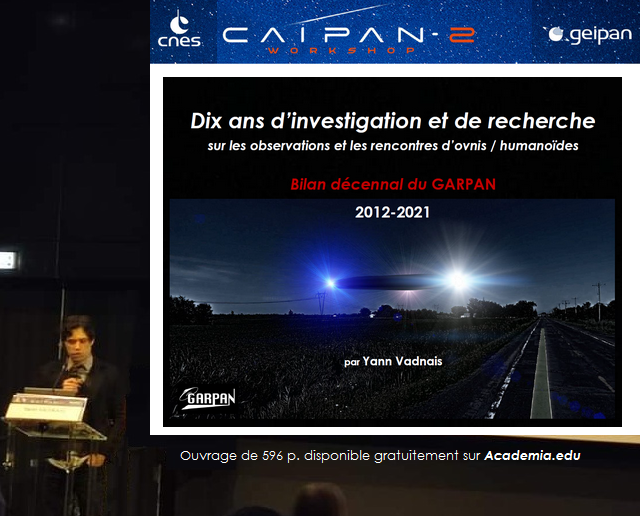
As I was the youngest participant (40 years) and that I came from abroad, it was quite normal that I begin by briefly summarizing my achievements in ovniology, because I had to justify the ambitious proposals that I was about to state in the rest of my communication. To avoid self-promotion, I took the trouble to show in parallel — based on the example of my background — a unique design, namely the “six levels of activity” in ovniology :
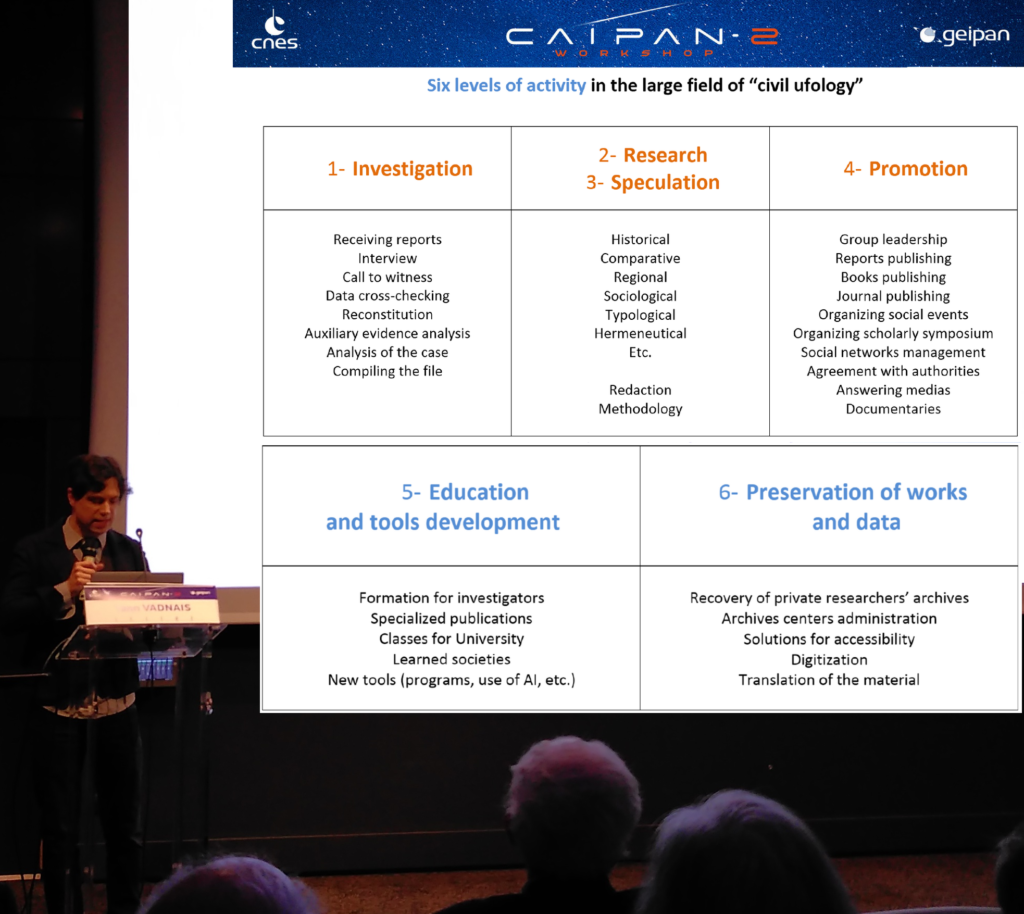
As mentioned above, I especially enjoy it for pay homage to the Canadian tradition of ovniology that preceded me and who deserves to be better known internationally :

I then indicated, for argument, the number of journals dealing with ovniology published according to national traditions (or country), in which Canada ranks fourth (with Italy, Germany, Denmark and Australia) :
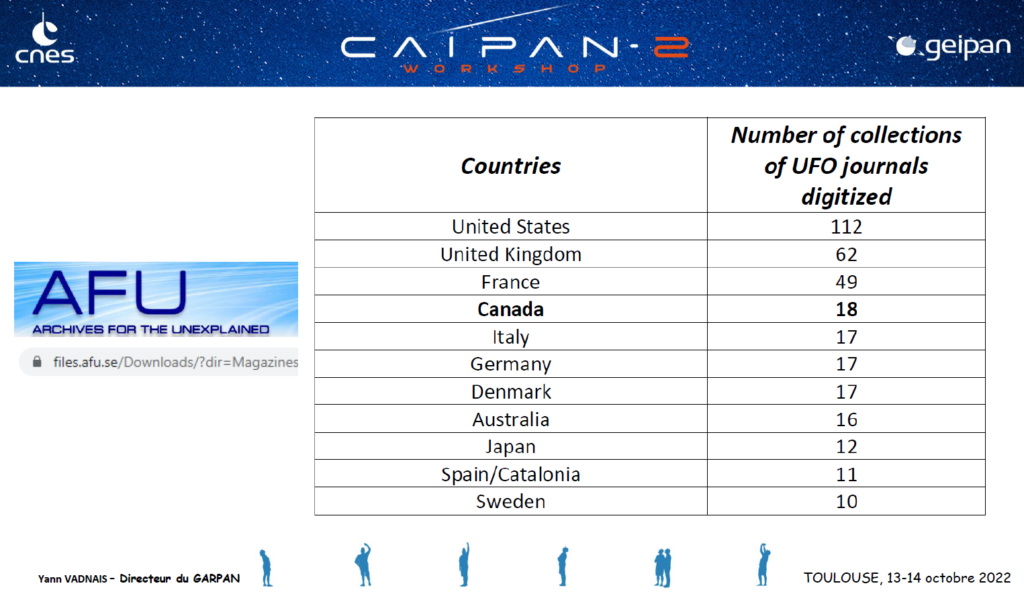
The premier point principal of my presentation was about “next steps to consolidate rigorous research in ovniology”, which I envision in three stages. In my opinion, we can consider that the research and promotion of ovniology has reached the second stage for a few decades ; at least since 2017, with the resurgence of geopolitical interest in the issue in the United States, and more recently (in 2022) With l’San Marino diplomatic initiative (interview in Italian with Roberto Pinotti) who wants to encourage’Organization United Nations (HIM) to create a permanent structure for the organization of international conferences presenting the actual results of work in ovniology.
As I was invited as president of the sociélearned tee SIÉTO, I went to the colloquium of the “Atelier CAIPAN 2 with the intention of promote the efforts and approaches falling within the third stage of the consolidation of rigorous research in ovniology, namely the one leading to their institutional recognition :
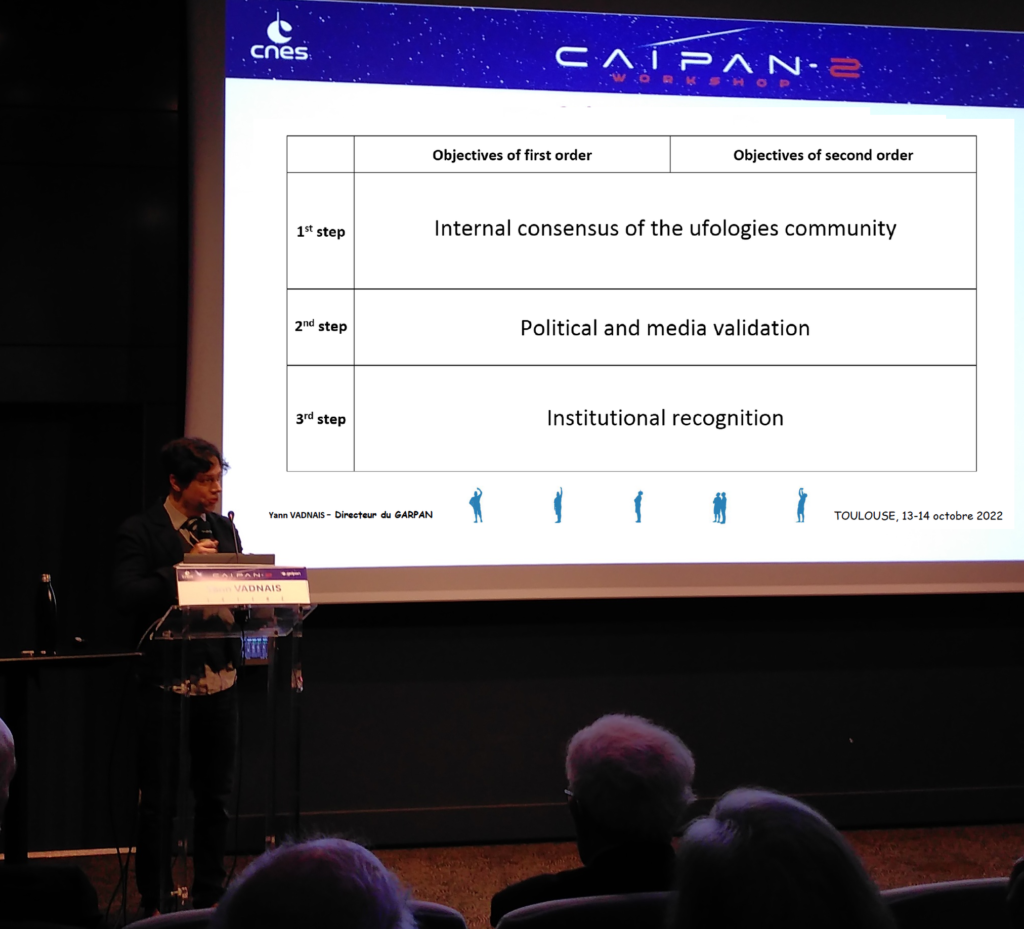
My argument was to argue that : so long as ovniological research will not operate like other normal human sciences (like sociology, the story, comparative literature or ethnology), until researchers publish genuine academic journals and that their studies will not be supervised by university departments, we will remain the laughingstock of the academic world, which seriously hampers the scrutiny of the rigorous work and multidisciplinary research that is carried out in the field of ovniology. I defended that’it is essential to put an end to the dissensions conditioned by divergent approaches and that it is urgent to raise the standards of interdisciplinary collaboration in order to subscribe to the imperatives of the third stage of the development of ovniology which will eventually allow adequate recognition of the concrete results and heuristic interests of UFO studies by knowledge institutions.
The quinze minutes of my conference did not allow me to go into the details of these three demanding and multi-criteria stages, but my Powerpoint (which will soon be published on the website of the GEIPAN / CNES) will allow researchers to consult the details of the thirty-six slides I presented :
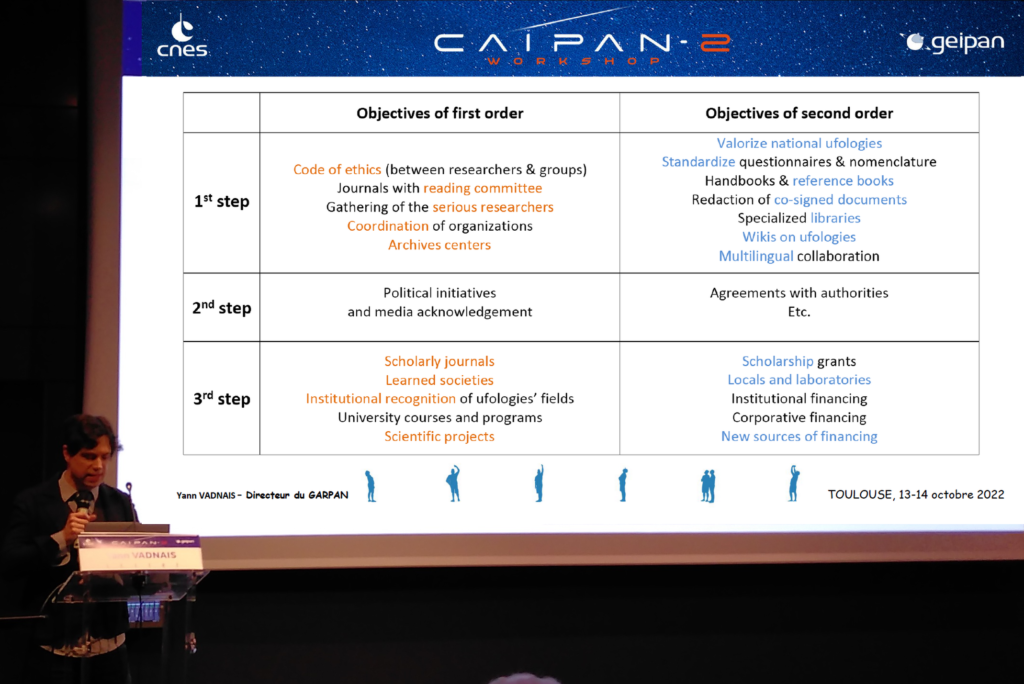
The second point principal de ma communication concerned one of the crucial tasks of contemporary ovniology, about which I have spoken with many North American and European colleagues since 2018. This is the taxonomic division of the “genera of ovniologies” : this classification is not insignificant and has not been mentioned lightly. I made it clear that the division of genres of research objects in ovniology is a prerequisite for the correct appreciation of their specificities.
I have therefore postulated that the vast field of UFO research includes AT LEAST four distinct genres of ovniology — which should always be methodologically distinguished. Please note, however, that when we receive UFO reports or raw testimonials, we do not know initially what kind of ovniology the case in question will belong to :
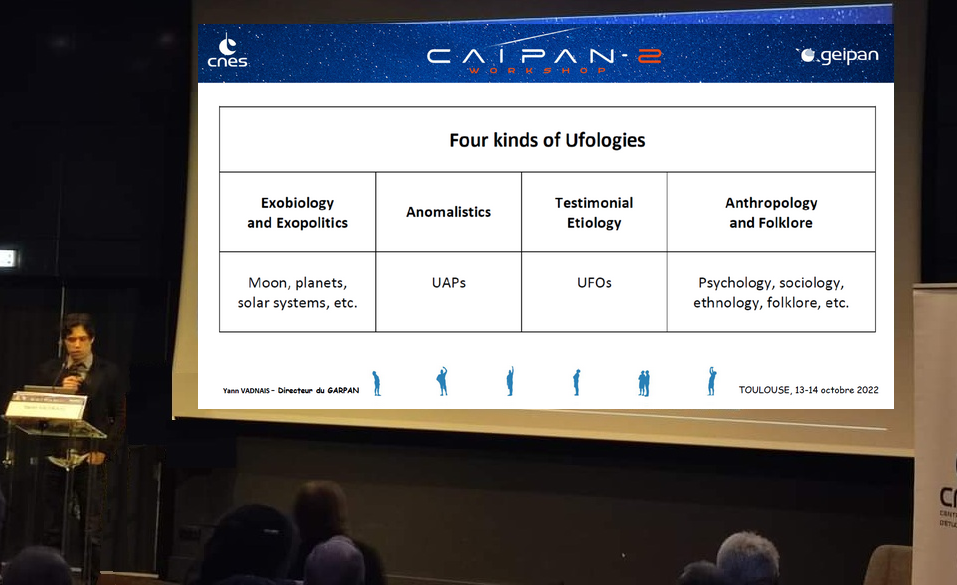
Auxiliary, I raised in passing the fragile coherence of the definition of "PAN » in use in the Francophonie and in the Anglosphere (STEAM, « Unidentified Aerial Phenomena »), insisting on the merits of the categorization of ovniological phenomena proposed by Jenny RANDLES from 1982. The resulting definitions are based on four types of lived experience (ontologically distinct and phenomenologically personalized). For example, a sighting of unidentified lights during the day before is radically different from a scripted lived experience during sleep ! :
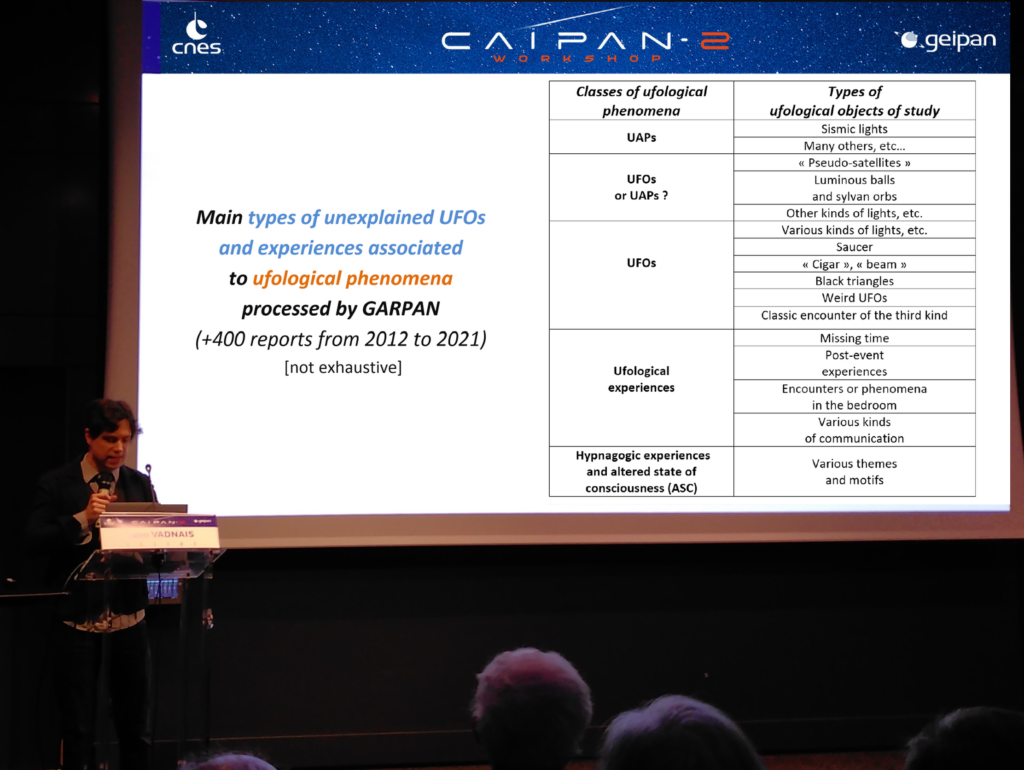
Inspired by this constellation of ideas reasoning on the epistemological foundations and the interdisciplinary dimensions of ovniology, I took the opportunity to invite our international colleagues to consolidate our tradition of ovniological studies by relying on the major works of our specialized literature and on the most esteemed authors. One of the major contributions to anomalistics and to the etiological approach is of course the database of 6 000 anomalies that physicist William R. CORLISS has listed according to nine classes of anomalies :
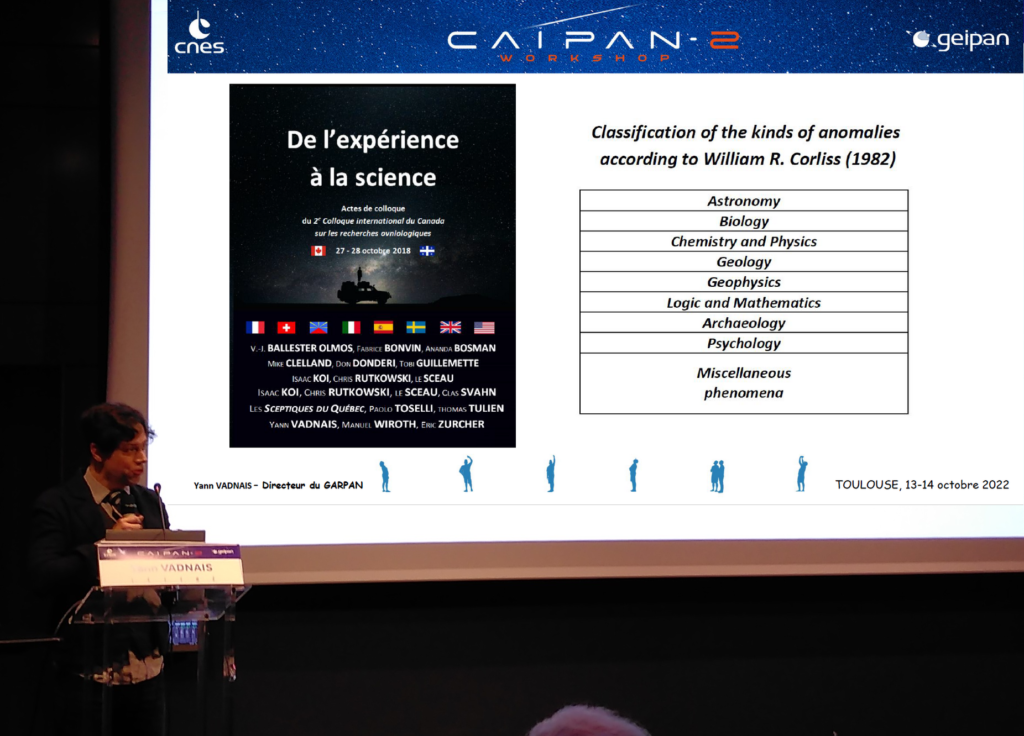
As I am a researcher in the history of ideas and ancient comparative literature, it was important to me to introduce the audience to a notion that I have methodologically favored for several years in my research on the phenomena associated with UFO sightings, namely the notion of “testimonial etiology”, who is unpublished in this area of research :
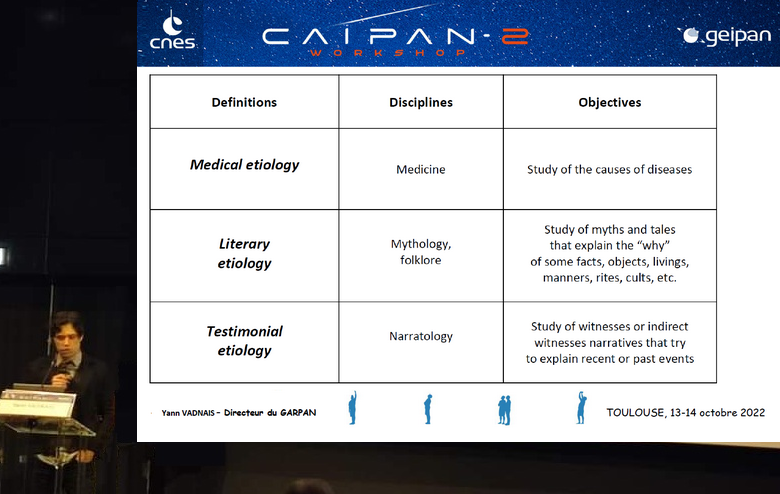
Finally, let us recall the secular state of affairs which makes funding extremely rare in the field of ovniology. So, next to the launch of the scholarship of 1 000 $ CA which will be awarded annually by the SIÉTO, I was proud to announce the allocation of four honorary donations to four of the most respectable and productive UFO organizations (who were in the conference room) :
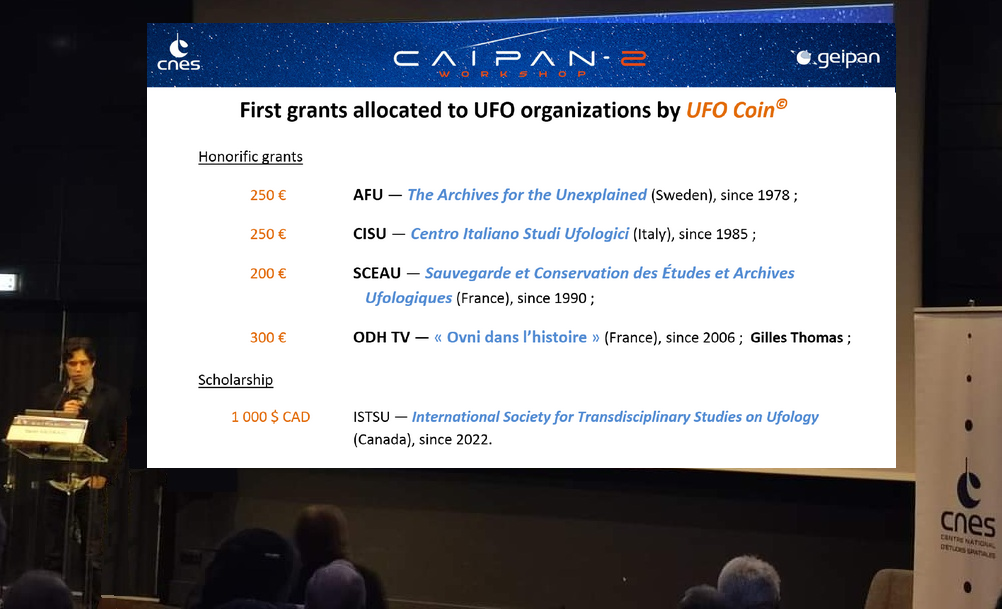
In conclusion, I am happy to have participated in this international colloquium organized by the GEIPAN and theand Cbetween national space studies (CNES). I only wish I had properly represented the society onmitten SIÉTO and Canadian ovniology as a whole !
On the sidelines of the conference, the organizers offered a buffet dinner at the Mercure Hotel, while Edoardo Russo (CISU) and Didier GOMEZ took care to program two other dinners which allowed the participants to rejoice among comrades and to promote convivial meetings. :
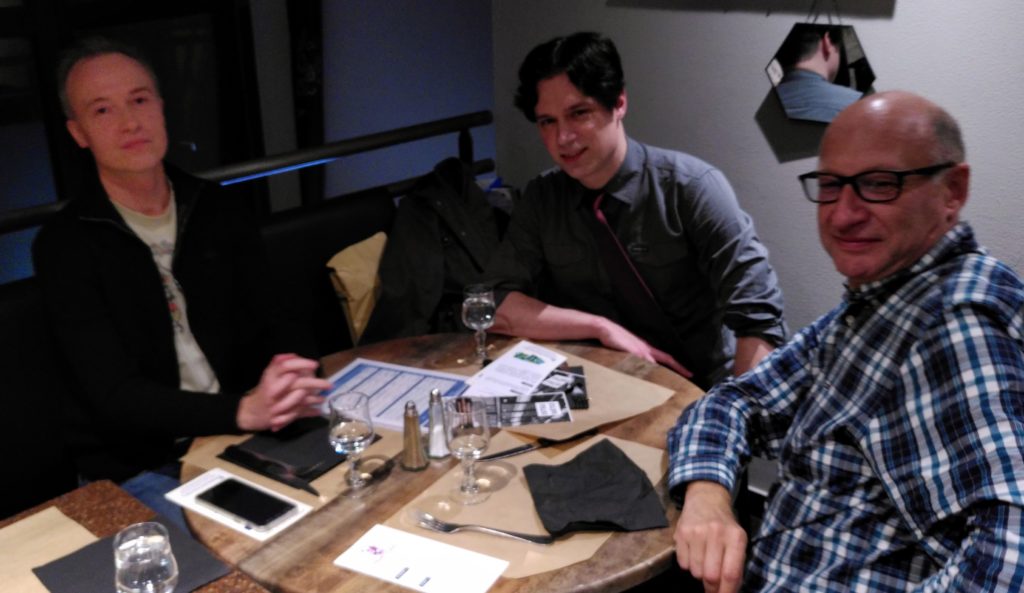
*




